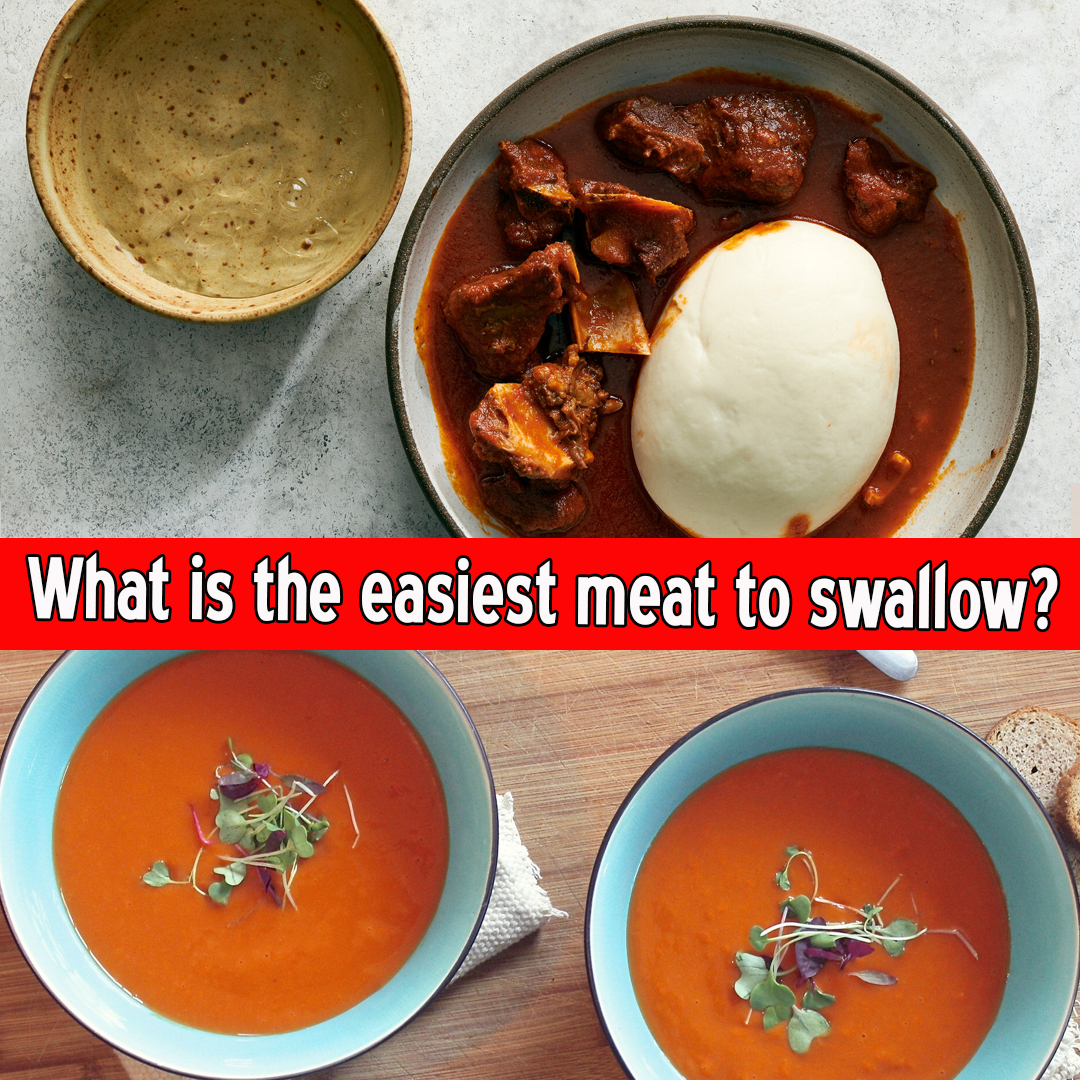What Is the Easiest Meat to Swallow?
When it comes to choosing meats that are easy to swallow, especially for people with swallowing difficulties (dysphagia), dental issues, or recovering from surgery or illness, the texture, moisture, and tenderness of the meat become crucial. Not all meats are created equal in terms of ease of swallowing. While flavor and nutrition are important, safety and comfort should come first for those who need soft, easy-to-swallow meals.

What is the easiest meat to swallow?
Understanding the Importance of Swallow-Friendly Meats
Swallowing may seem simple, but it’s actually a complex process involving muscles in the mouth, throat, and esophagus. For individuals who suffer from dysphagia—a condition that impairs the ability to swallow—consuming certain foods can be uncomfortable or dangerous due to the risk of choking or aspiration (food entering the lungs).
Elderly people, individuals recovering from throat surgery or radiation therapy, stroke survivors, and those with neurological disorders (e.g., Parkinson’s disease, ALS, multiple sclerosis) are often placed on soft or pureed diets. Even people with temporary issues like sore throat, dental surgery, or jaw pain may prefer easier-to-swallow options.
Criteria for “Easy-to-Swallow” Meats
Here are the key traits that make meat easier to swallow:
- Tenderness – Meats with softer muscle fibers or less connective tissue are less chewy and easier to break down.
- Moisture – Dry meat increases the risk of choking. Moisture helps food slide down the throat smoothly.
- Texture – Finely shredded, ground, or minced meats are easier than chunks or slices.
- Low Fat and Connective Tissue – Fat and sinew can be rubbery or stringy, making chewing and swallowing difficult.
- Preparation Method – Slow cooking, steaming, or braising often improves the softness and juiciness.
The Easiest Meats to Swallow
Here is a detailed look at meats considered the easiest to swallow, listed from easiest to moderately easy:
1. Ground Chicken or Ground Turkey (Cooked Moist)
- Why It’s Easy: Ground poultry is lean, mild, and softens well when cooked with moisture.
- Preparation Tips: Add broth, gravy, or sauce to keep it moist. Avoid overcooking. Serve with mashed potatoes or soft vegetables.
- Ideal For: Dysphagia patients, post-dental surgery diets.
2. Fish (Especially White Fish and Salmon)
- Why It’s Easy: Fish flakes naturally, requires minimal chewing, and is moist when steamed or poached.
- Best Types:
- Cod: Mild and tender
- Tilapia: Soft texture, not too oily
- Salmon: Rich in omega-3s, soft flakes
- Preparation Tips: Steam or bake with a little olive oil or butter. Avoid frying.
3. Pulled Chicken or Pulled Pork (Well-Cooked)
- Why It’s Easy: When slow-cooked, these meats become stringy but tender and moist.
- Preparation Tips: Use slow cooker recipes. Add sauces or broths. Shred the meat finely.
- Caution: Avoid pieces with skin or tough fibers.
4. Ground Beef (With Gravy or Sauce)
- Why It’s Easy: When finely ground and moistened, beef becomes easy to chew and swallow.
- Preparation Tips: Cook thoroughly with onions, tomato puree, or beef stock. Serve as meatballs, patties, or in shepherd’s pie.
5. Meatloaf or Meatballs (Soft Texture)
- Why It’s Easy: Made with ground meats, eggs, and breadcrumbs, they are soft and bind well.
- Preparation Tips: Add grated vegetables and moisture-rich ingredients. Cook in tomato sauce or gravy.
6. Eggs (Soft-Cooked)
While not technically meat, eggs are an excellent protein source and very easy to swallow.
- Scrambled eggs: Soft and moist
- Poached or boiled: Less ideal unless mashed
- Omelets with soft fillings: Ideal for breakfast or light meals
Cooking Methods That Improve Swallowability
The method of preparation is just as important as the meat itself. Here are the best ways to cook meat for easy swallowing:
1. Slow Cooking
- Why: Breaks down connective tissues and infuses moisture.
- Best Meats: Chuck roast, pork shoulder, chicken thighs
2. Steaming or Poaching
- Why: Gentle methods that retain moisture
- Ideal For: Fish, poultry
3. Braising
- Why: Long cooking in liquid makes meats fork-tender
- Use With: Beef stew, lamb shank
4. Grinding or Shredding
- Why: Reduces chewing effort
- Use Tools: Food processors or forks
Meats to Avoid if You Have Trouble Swallowing
Some meats pose more difficulty for people with swallowing challenges:
- Steak: Tough and fibrous, even when tenderized
- Bacon: Crispy or fatty bits can be a choking hazard
- Sausages: Casing may be hard to chew
- Dry Chicken Breast: Easily overcooked and dry
- Fried or Breaded Meats: Dry and hard on the throat
- Chewy Cuts: Brisket, flank steak, lamb chops (unless very well cooked)
Pureed or Minced Meat Alternatives
For more severe swallowing difficulties, meats can be pureed:
- Pureed Chicken or Turkey: Cooked, then blended with broth or gravy
- Pureed Meat Stew: Blend the entire stew into a smooth texture
- Commercial Pureed Meats: Available in hospitals or senior care settings
Pureed meats may not be as visually appealing, but they preserve nutrition and are safer for vulnerable individuals.
| Read more – Can dogs eat garlic? |
Meat Substitutes for Easy Swallowing
If meat is still too difficult to consume, here are protein-rich alternatives:
- Tofu: Very soft, can be scrambled or mashed
- Paneer (Indian cottage cheese): Soft when cooked with gravy
- Lentils or Dal: High-protein and easy to eat
- Eggs: Versatile and gentle on the throat
- Protein Smoothies: Whey or plant-based, blended with fruits
Health Conditions That Require Soft Meats
1. Dysphagia (Swallowing Disorder)
- Caused by stroke, dementia, aging, or cancer
- Soft and moist meats recommended
- Thickening agents used in soups and gravies
2. Post-Surgical Recovery
- After throat, dental, or gastrointestinal surgeries
- Pureed or minced meat is advised
3. Dental Issues
- People with missing teeth, dentures, or jaw pain prefer soft foods
4. Pediatric and Geriatric Nutrition
- Babies transitioning to solids and elderly adults both need soft, digestible meat options
Nutritional Considerations
Even for those with restrictions, protein intake is vital. Meats are excellent sources of:
- Complete proteins (contain all 9 essential amino acids)
- Iron (especially in red meat)
- Vitamin B12
- Zinc
Choosing the right texture allows continued consumption of meat while reducing risk.
Safety Tips for Consuming Soft Meats
- Chew thoroughly, even if meat is soft
- Avoid bones or gristle
- Moisten with sauces or gravies
- Cut into small, manageable pieces
- Eat slowly to reduce aspiration risk
For severe swallowing issues, consult a speech-language pathologist (SLP) or dietitian for a tailored dysphagia diet.
Sample Easy-to-Swallow Meat Recipes
1. Soft Chicken and Rice Casserole
- Ingredients: Ground chicken, cooked rice, carrots, cream of chicken soup
- Bake until soft and cohesive
2. Poached Salmon with Mashed Potatoes
- Steam salmon with lemon and herbs
- Serve with moist mashed potatoes and soft peas
3. Minced Beef with Gravy
- Brown ground beef, add onions, mushrooms, and beef stock
- Simmer until soft; serve over mashed vegetables
4. Pulled Chicken Wrap (for Mild Dysphagia)
- Use soft tortilla, moist shredded chicken, and mashed avocado
Conclusion
So, what is the easiest meat to swallow?
Ground poultry (chicken or turkey), soft-cooked fish like salmon, and moist preparations of shredded meats are among the easiest and safest options. These meats are tender, protein-rich, and easily adapted into meals for those with difficulty chewing or swallowing.
Selecting the right cut, cooking method, and consistency can significantly improve both the safety and enjoyment of meals. Whether you’re feeding someone recovering from illness or just looking for comfort food, prioritizing moist, tender, and soft meats will make a world of difference.
Always consult a medical professional or speech therapist for personalized dietary advice, especially for people with chronic swallowing issues.















Leave a Reply